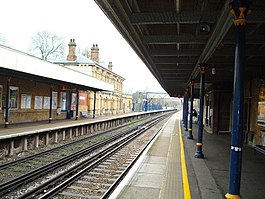Catford Bridge railway station
| Catford Bridge | |
|---|---|
 | |
| Location | Catford |
| Local authority | London Borough of Lewisham |
| Managed by | Southeastern |
| Station code | CFB |
| DfT category | D |
| Number of platforms | 2 |
| Accessible | Yes[1] |
| Fare zone | 3 |
| OSI | Catford |
| National Rail annual entry and exit | |
| 2018–19 | |
| – interchange | |
| 2019–20 | |
| – interchange | |
| 2020–21 | |
| – interchange | |
| 2021–22 | |
| – interchange | |
| 2022–23 | |
| – interchange | |
| Key dates | |
| 1 January 1857 | Opened |
| Other information | |
| External links | |
| Coordinates | 51°26′41″N 0°01′30″W / 51.4446°N 0.025°W |
Catford Bridge railway station is on the
History
Early years (1857-1922)

The Mid Kent line was built by the Mid-Kent and North Kent Junction Railway (MK&NKJR) and was opened on 1 January 1857 as far as Beckenham Junction (although it was not technically a junction as the West End of London and Crystal Palace Railway's line did not open until 3 May 1858).
From opening the line was worked by the
Seven years later the MK&NKJR built an extension from a new junction station at New Beckenham to Croydon (Addiscombe Road) which again was operated by the SER.[4]
Almost all services from the station have terminated at Charing Cross or Cannon Street stations but between 1880 and 1884 a service worked between
In 1898 the South Eastern Railway and its bitter rivals the London Chatham and Dover Railway agreed to work as one railway company under the name of the South Eastern and Chatham Railway and Catford Bridge became an SECR station.
Southern Railway (1923-1947)
Following the
The Mid-Kent line was electrified with the (750 V DC) third rail system and electric services commenced on 28 February 1926. Early electric services were worked by early Southern Railway 3-car Electric Multiple Unit trains often built from old SECR carriages.
Between 1927 and 1935 speculative house building west of the station saw an increase in commuter numbers.[6]
British Railways (1948-1994)
After World War II and following nationalisation on 1 January 1948, the station fell under the auspices of British Railways Southern Region.
The goods yard closed to general traffic on 28 December 1964 and to coal on 25 March 1968.[7] Colour light signalling was introduced between Ladywell and New Beckenham on 4 April 1971 with signalling being controlled by the signal box at New Beckenham. The small SER signal box which was located on the up platform was closed as a result. On 28 September 1975 the control of the signalling was transferred to London Bridge signalling centre.[8][9]
In May 1993 the up (towards London) side ticket office was destroyed by fire and following this a new ticket office was opened on the down side of the station.[10]
The privatisation era (1994–present day)
On 13 October 1996 operation of the passenger services passed to Connex South Eastern. Services were subsequently operated by South Eastern Trains, and Southeastern since 1 April 2006.
Services
All services at Catford Bridge are operated by Southeastern using Class 376, 465, 466 and 707 EMUs.
The typical off-peak service in trains per hour is:[11]
- 4 tph to London Charing Cross (2 of these run non-stop between Ladywell and London Bridge and 2 call at Lewisham)
- 4 tph to Hayes
On Sundays, the station is served by a half-hourly service between Hayes and London Charing Cross via Lewisham.
| Preceding station | Following station | |||
|---|---|---|---|---|
| Southeastern | ||||
Connections
In the media
The second episode of the 1979
References
- ^ "London and South East" (PDF). National Rail. September 2006. Archived from the original (PDF) on 6 March 2009.
- ^ "Out of Station Interchanges" (XLSX). Transport for London. 16 June 2020. Retrieved 5 November 2020.
- ^ Office of Rail Regulation. Please note: Some methodology may vary year on year.
- ^ Jackson, Alan A (1999). London's Local Railways (2nd ed.). Harrow Weald: Capital Transport Publishing. pp. 37–40.
- ISBN 1-873793-80-4.
- ^ Jackson, Alan A (1999). London's Local Railways (2nd ed.). Harrow Weald: Capital Transport Publishing. p. 47.
- ^ Jackson, Alan A (1999). London's Local Railways (2nd ed.). Harrow Weald: Capital Transport Publishing. p. 48.
- ^ Jackson, Alan A (1999). London's Local Railways (2nd ed.). Harrow Weald: Capital Transport Publishing. pp. 47, 48.
- ISBN 1-873793-20-0.
- ^ Jackson, Alan A (1999). London's Local Railways (2nd ed.). Harrow Weald: Capital Transport Publishing. pp. 47, 48.
- ^ Table 203 National Rail timetable, December 2022
- ^ "Buses from Catford" (PDF). TfL. 21 November 2020. Retrieved 22 August 2021.
Notes
- ^ The provision of the goods yard is stated as "in the 20th Century" by Vic Mitchell and Keith Smith in their book London Bridge to Addiscombe.
External links
- Train times and station information for Catford Bridge railway station from National Rail

